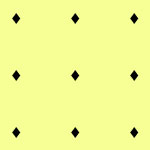There are a few planting systems available. For durian, square planting is usually practiced where the planting points are arranged in squares. In rectangular planting the planting points are arranged in a rectangular while in triangular system they are arranged in triangles. The arrangement of the different systems are illustrated below. Quincunx planting system is done with the addition of another seedling which is subjected to removal in the later years when the canopies of the durian trees touch each other. The Contour planting system is adopted if the slopes exceed 20%. The distance between terraces depends on the slopes.
Seedlings are usually planted 10-12 m apart.

Square planting

Rectangular planting

Triangular planting

Quincunx square planting

Quincunx rectangular planting
 Permanent planting point Permanent planting point
 Planting point to be removed later Planting point to be removed later Figure 1: The different planting system practised in durian cultivation
Seedlings from the nursery need to be hardened before planting. Shade is gradually reduced to 25%. The twice daily watering is reduced to once.
A planting hole measuring 0.6 m x 0.6 m x 0.6 m is adequate for sandy loam soil. For lateritic soil or drought areas a slightly bigger hole is necessary. The holes can be dug either manually or with machinery at least a month before planting. Each hole is filled up with top soil, organic fertiliser, ground magnesium limestone and phosphate fertiliser. A small hole is again dug into the soil mixtures before planting.
The polybag containing the seedling is carefully removed before planting. Hilling up at the root region is necessary to protect the roots from drying out. Support is given to the seedlings to maintain an erect position. The seedling is protected from the hot sun by covering its top with a bamboo basket attached to a support. Sometimes fronds from palm trees are used to provide shade up to 6 months. Banana plants can also be planted to provide temporary shade. They are then removed after 3 years. |

